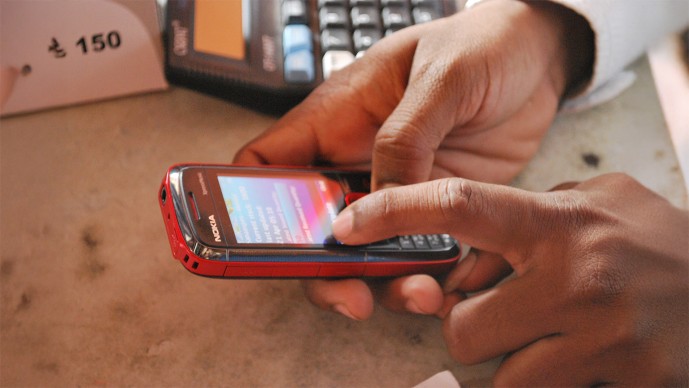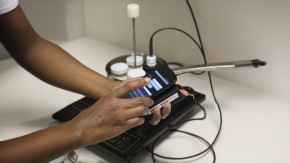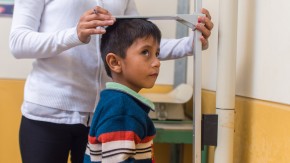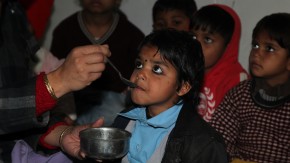
We spend a lot of time in the development community talking about the "last-mile problem." This refers to the most difficult part of getting any health care to the people who need it. It's easy to deliver supplies like vaccines and medicine to a national facility; it's not too hard to transport them from the national facility to regional storage and even from there to district storage. And that's where it gets incredibly difficult. Because in a country like India, getting supplies up mountains, across rivers, and through forests to local health centers that serve 1.4 billion people is incredibly time-consuming, expensive, and difficult. For a lot of those people, the last mile isn't even over at that point. 200 million Indians live almost 20 miles from the nearest health center, so to get there they have to trek, climb, and row for an entire day. Imagine you're one of those people, and you want to vaccinate your kid. You take an entire day to make the 20-mile journey to the health center with your child, only to be told that there are no vaccines in stock. Imagine, too, that this is the third time this has happened. How likely is it that you're going to try again? This happens over and over again around the world, and the result is that parents lose faith in the health system and give up on getting their children vaccinated, and children die. But supply-chain expert Anup Akkihal, founder and CEO of Logistimo, has worked with his team to figure out a way to help keep this from happening.
Until about ten years ago or so, health systems in low- and middle-income countries had a tried and true way to keep track of how much of what medicine was stocked where: they wrote it down on paper. The national office allocated drugs to the regional offices based on population estimates, the regional offices allocated drugs to the district offices, and so on. There was no real way for the people making the decisions about what went where to find out about surpluses or shortfalls until news spread of a stockout. At that point, the regional and district offices could adjust to cover shortfalls, and the adjustments would gradually trickle down.
To Akkihal, who had been working in supply-chain logistics ever since getting a master's degree in supply chain logistics from MIT, the field seemed ripe for digitization. So in 2012, using two grants from a Grand Challenges Explorations (GCE) call for proposals to design new approaches for optimizing immunization systems, he and his team set up digital logistics management information systems (LMIS) in the seven-month-old country of South Sudan and in the Biligirirangana Hills of the Indian state of Karnataka.
Now, to people living in rich countries, the idea of digitizing a paper-and-pencil system may seem so obvious as to need no explaining. But it's worth considering the things it allowed government and health workers to do. Yes, ministries of health could keep much better records of what drugs went where. But that was just the beginning. Digitization transformed what had been a push system - drugs and information went one way, from the center outward - into a two-way system. If a single health center was dangerously low on a critical medication, a district manager could see it immediately and transfer the medication from a health center where there was a surplus before a single person who needed the medicine was turned away. What's more, the system was flexible enough that healthcare workers found entirely unexpected uses for it. When violence broke out in the Northern Bahr el Ghazal region of South Sudan, for example, a healthcare worker used Logistimo's system to change the address of the health center, instantly connecting the new location to the national supply chain; then he spread the word to nearby villages that people who needed medicine should go to the new address because the old one was too dangerous. He sent a message through the Logistimo system explaining what he'd done. "I hope I didn't break anything," he wrote.
Though the violence in South Sudan interrupted Akkihal's project there, the LMIS in India was, to put it bluntly, a spectacular success: stockouts using the new system went down to significantly under 1%. The national government took notice and began aggressively adopting the system, which went by the name "Bulletin Board." As of today, Logistimo covers every single health center in 21 states (out of 29) - that's about 25,000 health centers, providing half a billion vaccine doses a year to over 100 million kids. By the end of 2020, the system will cover all of India. The government has also integrated Logistimo's LMIS with a system developed by another GCE grantee, Nexleaf, so that kids don't just get the right quantities of the right vaccines at the right time - they also get those vaccines stored at the right temperature, which is crucial to their effectiveness.
Other countries have taken notice. Indonesia, Myanmar, Zambia, Uganda, Somalia, The Democratic Republic of Congo, and Angola have all started or are starting their own programs or pilots with Logistimo. Akkihal and his team, meanwhile, now that they've figured out availability, are working on the next part of the last-mile problem: actually getting medicine to villages rather than making people walk 18 miles. Logistimo's third-party-logistics division currently makes about 20,000 deliveries a month in Southern India and is expanding rapidly.
There are a lot of people in the development community who are very good at what they do. But they don't know everything, and people like Anup Akkihal and his team are a great reminder of that. It took people whose backgrounds had nothing to do with global health to start solving a problem that's stymied global health workers for decades. And the beneficiaries are the millions - maybe one day billions - of people around the world who will get reliable access to reliable medicines that can save their lives and those of their children.



